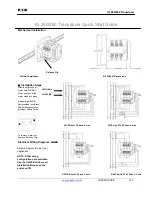
MDS
SDM9
Quick
Start
Guide
(x790
Mode)
The MDS SDM9 transceiver (
Figure 1
) is a software-
configurable, industrial Master Station solution for use
in wireless telemetry applications. In this guide, the
term
SD
is used for information common to all models
of the radio. This radio module is designed for use
with a card cage and backplane similar to that shown
in Figure 3, and to be used with a variety of data
control equipment such as remote terminal units
(RTUs), programmable logic controllers (PLCs), flow
computers, and similar devices. Data interface
connections may be made by both serial (RS-
232/485) and limited Ethernet protocols.
Invisipbllhaeoc led er
Figure 1. MDS SDM9 Data Transceiver
1.1 About This Guide
This guide covers SDM9 transceivers operating in
x710-Compatible Mode.
All GE MDS manuals are
available free of charge at
www.gemds.com
.
Invisipbllhaeoc led er
There are three main requirements for installing the
transceiver:
• Adequate and stable primary power
• An efficient and properly installed antenna system
• Correct interface connections between the
transceiver and the data device.
Figure 2
shows a chassis with card cage and
backplane that this module would be typically installed
in. The backplane provides the 24V power
connection to this unit and provides the customer data
interfaces through the card edge connector on the
rear of the SDM9.
Figure 2: Typical Orbit Master Station Chassis.
The SDM9 modules may be installed in any free
peripheral slot of this chassis.
Figure 3
shows a typical installation of the radio.
NOTE:
Retrofit Kits are available to simplify
installation at former MDS x710 digital and analog
sites. Consult the
Reference
Manual
for ordering
details.
Figure 3: Typical Master Station Chassis with
SDM9 radio card installed. NOTE: Chassis has
antenna connection in rear
, with power and data
connections in the front.
2.1 Installation Steps
1. Install the transceiver into chassis as shown in
Figure 2.
NOTE:
To prevent damage to the SDM9 radio, wear a
wrist strap to prevent ESD discharge to the card edge
connector. Also, dress all cables as required to
prevent moisture from running along the cables and
into the radio.
1.0 INTRODUCTION
2.0 INSTALLATION






















